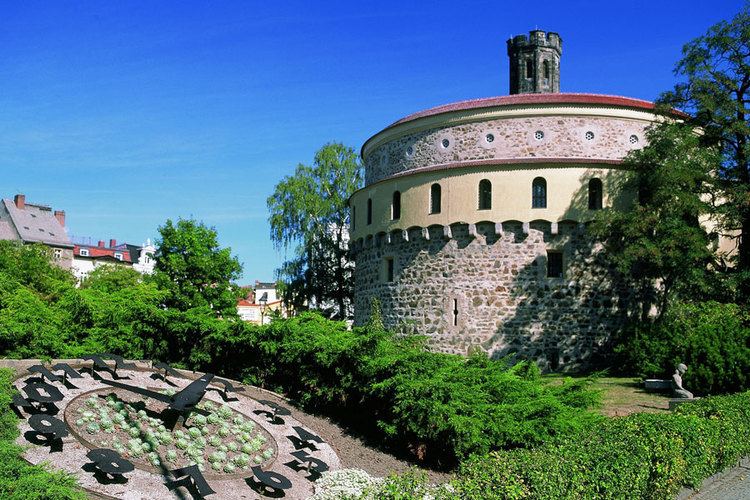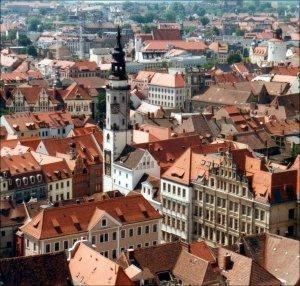Country State Mayor Siegfried Deinege | Population 55,928 (Dec 31, 2009) Area 67.22 km2 District Gorlitz | |
 | ||
G rlitz the oldest city in germany
Görlitz ([ˈɡœɐ̯lɪts ]; Polish: Zgorzelec, Upper Sorbian: Zhorjelc, Lower Sorbian: Zgórjelc, Czech: Zhořelec) is a town in Germany and the capital of the district of Görlitz. It is the easternmost town in the country, located on the Lusatian Neisse River in the Bundesland (Federal State) of Saxony. It lies opposite the Polish town of Zgorzelec, which was a part of Görlitz until 1945.
Contents
- G rlitz the oldest city in germany
- Map of Grlitz
- G rlitz kurzdoku
- History
- Arts culture
- Transport
- Film location
- Town twinning
- Notable people
- References
Map of Görlitz
Görlitz is the second largest town of Lusatia and the largest in Upper Lusatia. It belonged to the Electorate of Saxony after 1635. In 1815, due to the partition of Saxony, some parts of Lusatia were integrated into the Prussian Province of Silesia, and later into the Province of Lower Silesia. Görlitz is the largest town of the former Province of Lower Silesia that lies west of the Oder-Neisse line and hence remains in Germany today. Thus it is both the most Silesian town, in terms of character, and the largest in Germany today. The town combines Lusatian and Silesian traditions as well as German and Sorbian culture. It has around 55,000 inhabitants.

Görlitz has a rich architectural heritage. Many movie-makers have used the various sites as locations.
G rlitz kurzdoku
History

As a small Sorbian village named Gorelic in the region of Upper Lusatia in the March of Lusatia of the Holy Roman Empire, it was temporarily conquered and held by the Kingdom of Poland during Bolesław I Chrobry's invasion of Lusatia between 1002 and 1031, after which the region fell back to the March of Lusatia under the counts of the Margraviate of Meissen. Around 1072 the village was assigned to the duchy of Bohemia. The date of the town's foundation is unknown. However, Goreliz was first mentioned in a document from the King of Germany, and later Holy Roman Emperor, Henry IV in 1071. This document granted Görlitz to the Diocese of Meissen, then under Bishop Benno of Meissen. Currently, this document can be found in the Saxony State Archives in Dresden. The origin of the name Görlitz is derived from the Slavic word for "burned land", referring to the technique used to clear land for settlement. Zgorzelec and Czech Zhořelec have the same derivation. In the 13th century the village gradually became a town. Due to its location on the Via Regia, an ancient and medieval trade route, the settlement prospered.
In the following centuries Görlitz was a wealthy member of the Lusatian League, which consisted of Bautzen, Görlitz, Kamenz, Lauban, Löbau and Zittau. In 1352 during the reign of Casimir the Great, Lusatian German colonists from Görlitz founded the town of Gorlice in southern Poland near Kraków.
The Protestant Reformation came to Görlitz in the early 1520s and by the last half of the 16th century, it and the surrounding vicinity, became almost completely Lutheran.
After suffering for years in the Thirty Years' War, the region of Upper Lusatia (including Görlitz) was ceded to the Electorate of Saxony in 1635. After the Napoleonic Wars, the 1815 Congress of Vienna transferred the town from the Kingdom of Saxony to the Kingdom of Prussia. Görlitz was subsequently administered within the Province of Silesia, and, after World War I, the Province of Lower Silesia, until 1945.
Near the end of World War II, German troops destroyed all bridges crossing the Lusatian Neisse. The redrawing of boundaries in 1945—in particular the relocation of the German-Polish border to the present Oder-Neisse line—divided the town. The right bank became part of Poland and was renamed Zgorzelec by the Polish communist government in 1948, while the main portion on the left bank remained part of Germany, now within the state of Saxony. When the East German states were dissolved in 1952, Görlitz became part of the Dresden District, but the states were restored upon German reunification in 1990.
On 27 June 1994, the town became the seat of the Roman Catholic Diocese of Görlitz, but it remains a Lutheran Protestant stronghold.
In 2002 Lake Berzdorf, located south of Görlitz, began to flood. The Altstadtbrücke (literally old town bridge) between Görlitz and sister city Zgorzelec was rebuilt between 2003 and 2004. It was officially opened on 20 October 2004. As soon as Poland signed the Schengen Agreement (20 December 2007), movement between the two banks of the river again became unrestricted, since border controls were eliminated. Indeed, users of the new pedestrian bridge are not told by any signs that they are leaving one country and entering another.
Whilst the town was well preserved, it was notably grey and colourless under communist East German rule. Since reunification many buildings have been renovated. It is a popular place to which the elderly of Germany retire, being quiet and relatively affordable by German standards. Its tourist potential is rapidly expanding, being very much an eastern counterpart to towns such as Heidelberg.
Arts & culture
Today Görlitz and Zgorzelec, two towns on opposite banks of the narrow river, get along well. Two bridges have been rebuilt, a bus line connects the German and Polish parts of the town, and there is a common urban management, with annual joint sessions of both town councils.
The town has a rich architectural heritage (Gothic, Renaissance, Baroque, Neoclassical, Art Nouveau). One example of this rich architectural heritage is the Schönhof, which is one of the oldest civic Renaissance buildings in Germany. Another medieval heritage is a model of the Holy Sepulchre (de) which was constructed in the late 15th century.
In 2006 the twin city Görlitz/Zgorzelec applied to be the European City of Culture 2010. It was hoped that the concept of Polish-German cooperation would be sufficient to convince the jury, but Essen won. Görlitz was placed second. As a result of the campaign Görlitz was renamed City of Culture in order to further German-Polish relations and to attract tourists from all over the world.
As Görlitz was part of Silesia from 1815 onward, it has a Silesian Museum dedicated to the region (Schlesisches Museum zu Görlitz) and even holds a Silesian Music festival (Schlesisches Musikfest). In addition, Görlitz is the seat of the Silesia Youth Group (Schlesische Jugend). There is also a newspaper in Görlitz called the Lower Silesian Kurier (Niederschlesischer Kurier).
Transport
Görlitz station is on the Berlin – Görlitz and the Dresden – Görlitz lines of Deutsche Bahn. The station also provides an international connection to Wrocław, Poland.
Local public transport is provided by:
Film location
Due to the historical parts of the city, many movie-makers have used the various sites as locations. Quentin Tarantino shot the movie-in-a-movie Stolz der Nation (Pride of the Nation) for Inglourious Basterds (which incidentally purports to be Sicily) on the Untermarkt and Obermarkt in Görlitz' oldest parts of the city. Other films shot in Görlitz include the 2013 war drama The Book Thief and the teen years in The Reader. Görlitz was used as the primary shooting location for the Wes Anderson film The Grand Budapest Hotel, with Görlitz standing in for a resort in the fictional Eastern European country of Zubrowka. A vacant department store in the city was redecorated to serve as the hotel itself.
Town twinning
Görlitz is twinned with:
Being the easternmost town in the country, Görlitz has formed a "Compass Alliance" (Zipfelbund) with the northernmost, westernmost and southernmost towns, List, Selfkant and Oberstdorf respectively. They always participate in the German Unity Day celebrations to represent the modern limits of Germany.
